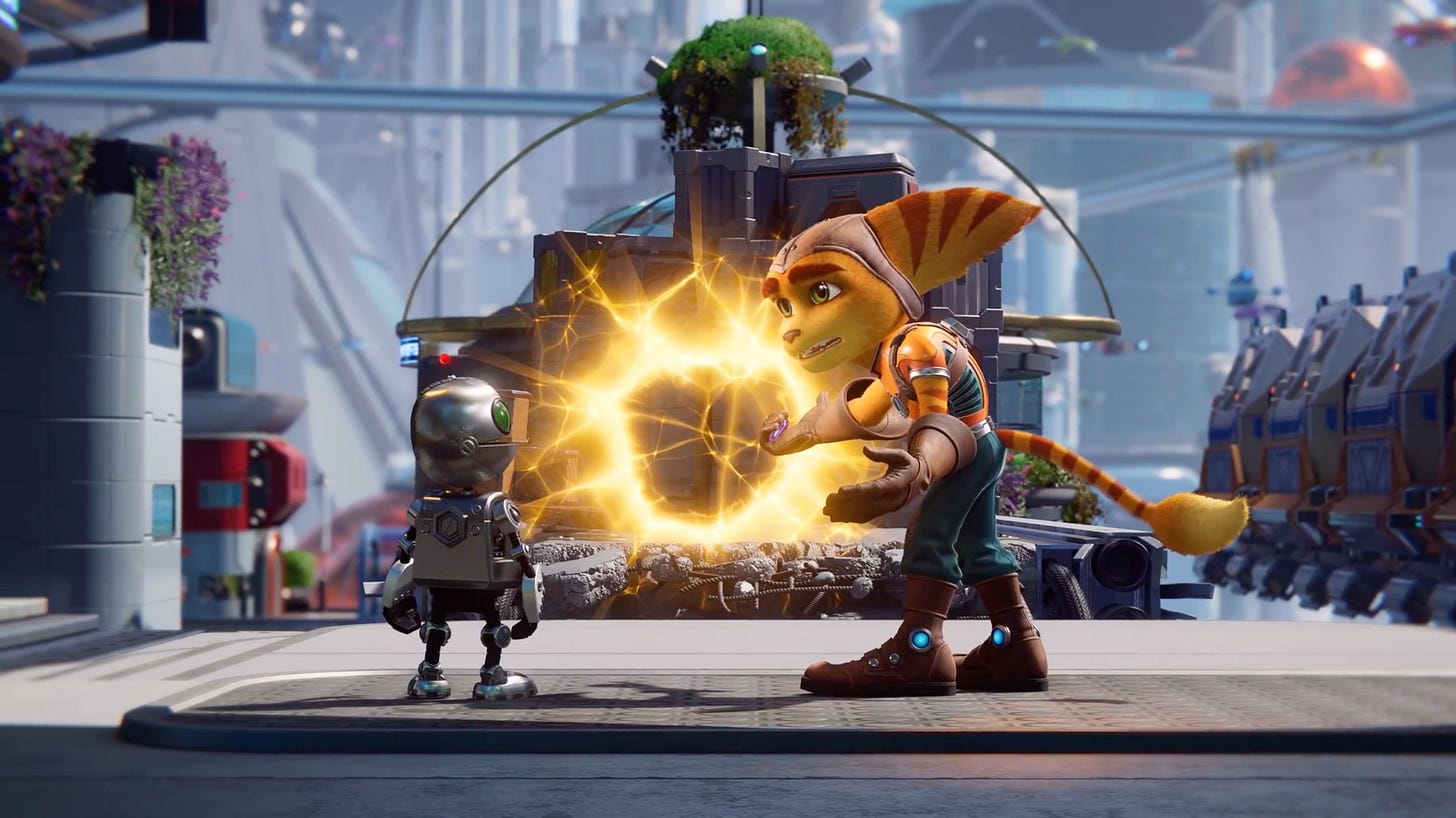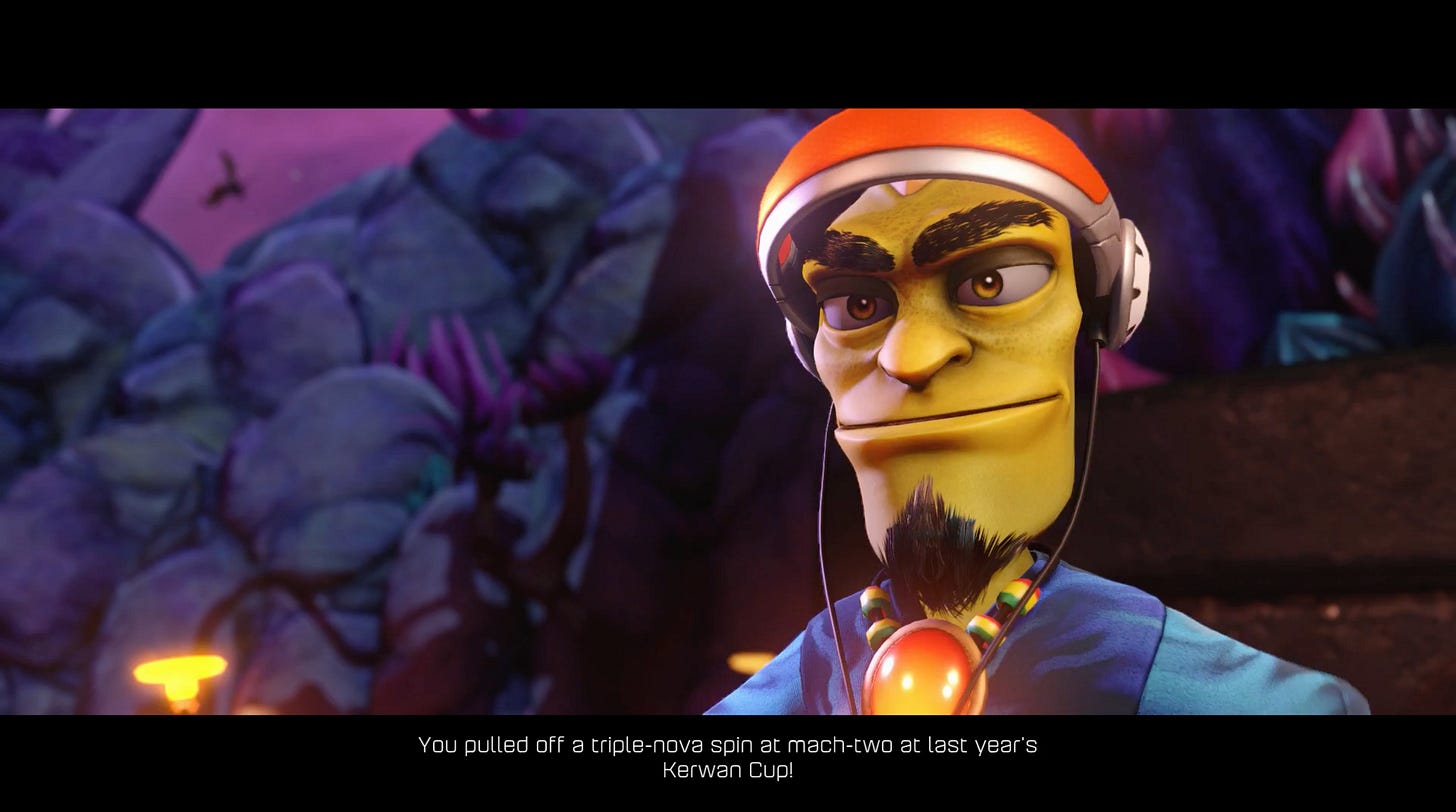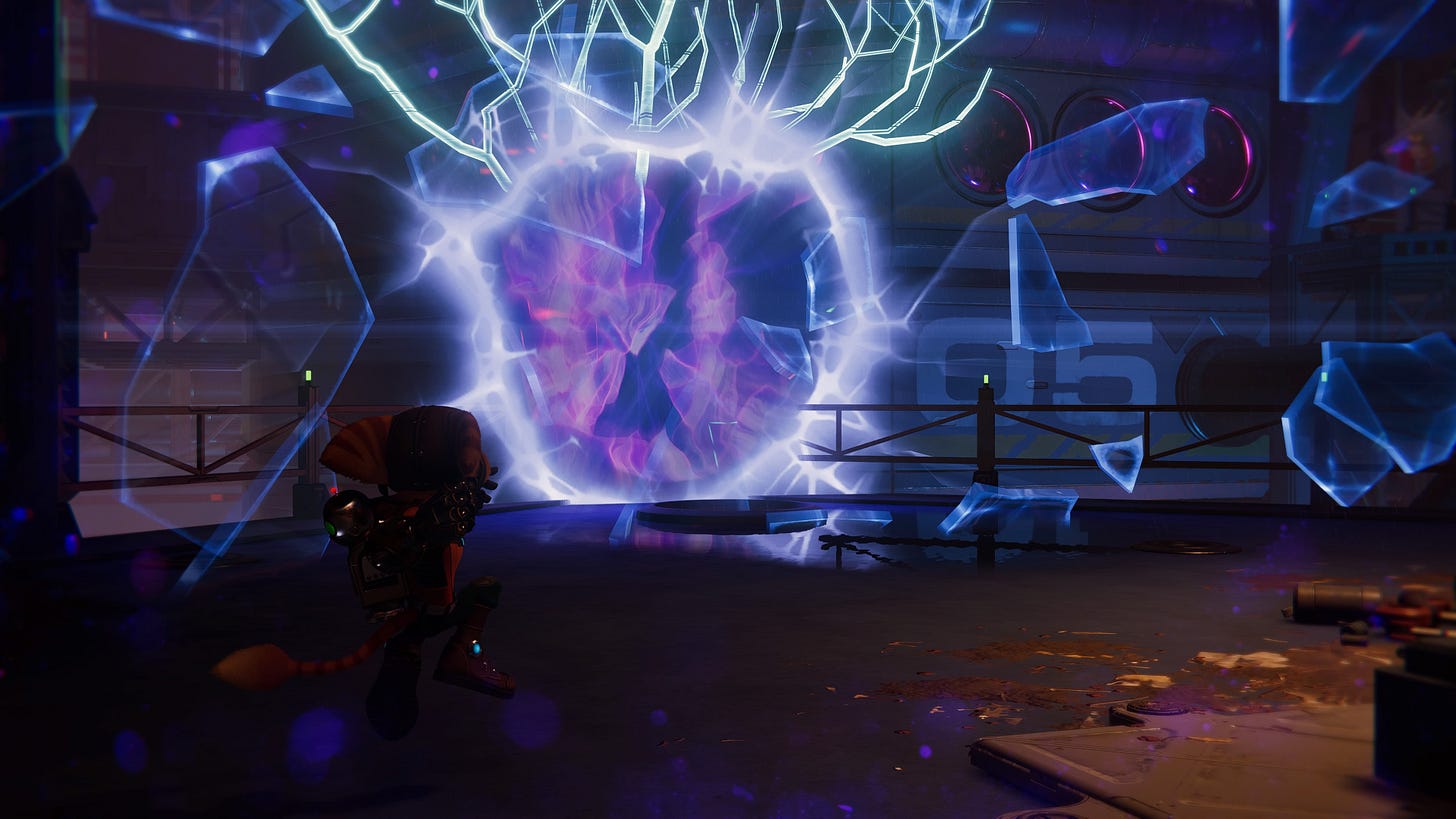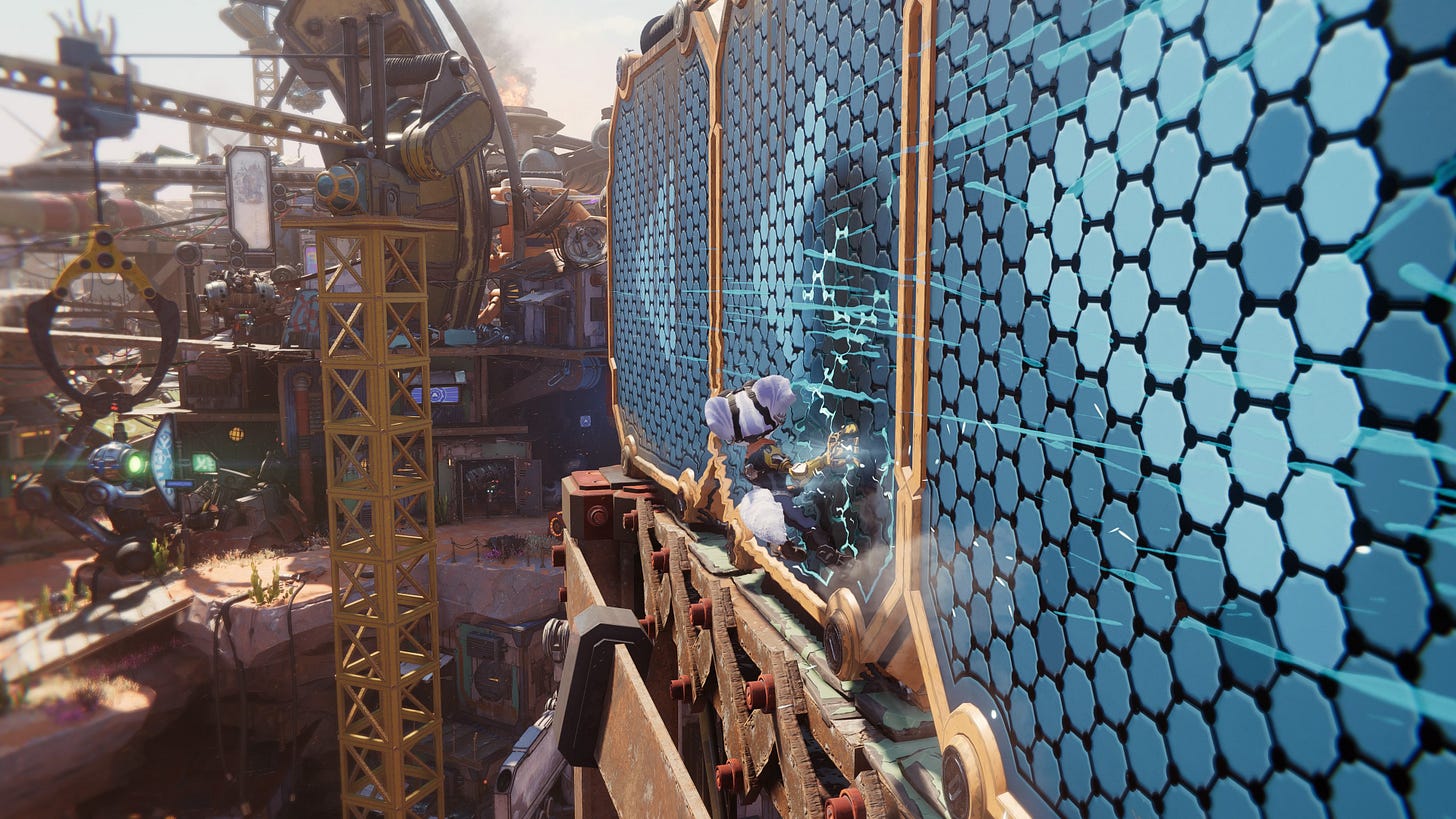So, in my first ever piece on this stack, I discussed what I felt to be a lack of cheaper video games, a lack of experimentation on smaller projects. Well, one of the games I pointed to in this piece as an example of what can be accomplished when green-lighting smaller-scale projects was the 2016 rendition of Ratchet and Clank for the PS4, a budget title that launched at $39.99. In discussing this game, my main point was that a Ratchet and Clank game in 2016 wasn’t necessarily guaranteed to be a smash hit, so it made sense to produce it at a smaller budget paired with a similarly cheaper price. Well, the bet worked, with the PS4 game taking the title as the fastest-selling Ratchet and Clank game at its release.
So then, due to Ratchet’s success on PS4 and Sony having acquired its developer, Insomniac Games, in 2019, it seems to have made perfect sense to start development on a new, higher-budget installment in the franchise. The result is Ratchet and Clank: Rift Apart for PS5, a truly remarkable game that takes the most advantage of the PS5’s various hardware features of any game we’ve seen thus far (I hesitate to say “full advantage” because games rarely unlock the full power of their machines until much later into the lifecycle of said machines). Though it’s not without its flaws, I loved my time with Rift Apart and feel it will be looked back upon as one of the defining titles of the early days of PS5.
Visuals/Technical Discussion
So, when it comes to Ratchet and Clank on PS4 (henceforth known as “Ratchet 2016” or “2016”), one of the aspects of that game that tipped me off to its lower production value was its cutscenes and the animation within. The animation for several sequences was a bit stilted and lacked polish. What comes to mind for me specifically are the cutscenes on Aridia featuring Skidd McMarx, whose animation while talking is very clunky and kind of gives away the lower-budget nature of the game.
In contrast to 2016, Rift Apart’s animation is top-tier, almost approaching full-length CG films a la Pixar. The quality of facial animation on display here in particular is simply jaw dropping. The eyes on Ratchet and Rivet have this lifelike sheen and the overall expressiveness of the faces are greatly improved from the previous title. Then there’s the strand system, a way to render hair first introduced in Insomniac’s Spider-Man: Miles Morales, that gives Ratchet and Rivet’s furry exteriors a new level of definition.
In regards to environment rendering, Rift Apart delivers the goods with large, open, fully realized worlds. Though, the big advancement comes in the form of the ray-tracing (also used in Miles Morales) that’s used to better simulate reflections on reflective surfaces. Take Clank, for example. While he’s on your back, you can see little details of what’s being rendered behind the camera, a feat that simply wouldn’t work without the use of dedicated ray-tracing hardware like that in the PS5.

So then, Rift Apart looks fantastic, utilizing the uplift in performance gen-on-gen to produce some truly stunning visuals; however, nothing that I’ve described so far about Rift Apart means it wouldn’t not run on PS4 if you turned off some features or reduced the overall graphical quality. Rift Apart’s big advancement comes in the form of its titular rifts, little tears in the world that allow you to travel seamlessly between different dimensions. The way games work is that all of the necessary information for rendering and game logic must be stored in main memory, of which the PS5 has 16 GB. This presents a problem for the rift mechanic in that, if you want to have a completely different world with different textures and NPC and whatnot behind a rift, you would conventionally need to keep those assets in main memory along with whatever is being rendered in front of you so that it could be rapidly accessed, taking away some flexibility in rendering from both. However, due to the PS5’s super fast SSD, game assets can be loaded into main memory at a rate that can fully saturate 16 GB in a matter of seconds, depending on how the data is compressed. Compared to the PS4’s meager hard drive, which has a theoretical data transfer rate of about 100 MB/s, the PS5’s SSD is lightning quick. This hardware advancement enabled the developers of Rift Apart to implement rifts; from the moment you press L1 on your controller to teleport through a rift to another dimension, assets from the current dimension are dumped in favor of those from the new one. All told, this process takes less than a couple of seconds, allowing for truly seamless teleportation in practice. I find it interesting that, for the first time in several years, we’re seeing an advancement in console hardware directly affect game design. It’s all neat stuff!
Gameplay
The gameplay in Rift Apart, however, is more of a mixed bag. The core act of exploration is pretty enjoyable. I mean, the level of visual fidelity on display alone makes these environments a joy to explore, but the levels are smartly laid out as to make traversing them an enjoyable experience. The new wall run and air dash mechanics along with mainstays like the grapple hook elevate traversal to something truly engaging. In a lot of platformers, previous Ratchet and Clank games included, the act of traversal can often be dumbed down to a simple exercise in judging gaps and jumping across them. In Rift Apart, there’s a bit more thought required in platforming. For example, you could have a setup where you have to jump off cliff, air dash to a wall, run along it, and then grapple onto a swinging point in order to cross a gap. These different mechanics can be combined in a myriad of ways in order to give a little bit more life back to platforming.
But my favorite traversal mechanic is the rocket boots that Ratchet acquires midway through the story. These boots allow you to glide across the landscape and speed up in a sort of skating fashion, affording really quick motion when going from place to place on more open planets. The problem, however, is that a small amount of the game is actually designed with the rocket boots in mind, but you can use them at any point after you acquire them. This leads to the boots feeling a bit underutilized in terms of actual level design, but because the game largely isn’t designed to utilize the rocket boots, you can exploit some of the levels, bypassing large portions of platforming. I kind of like this approach to level design, where there is an obviously intended path that the game doesn’t force you to take. If you’re creative and skilled enough with the rocket boots, you can sort of forge your own path through the levels.
Another major tenant of Ratchet and Clank’s design, going all the way back to the PS2 original, is shooting. The guns themselves are interesting, but the enemy design doesn’t really necessitate anything other than a pistol. I really related to dunkey’s description of Rift Apart being a sort of baby Doom Eternal. In Doom, each enemy is a sort of puzzle where they have a certain weak spot that you have to exploit. For example, the big floating cyclops guy that I can’t remember the name of right now is weak to grenades because he chokes on them. Because of this, you can throw a grenade at him or use the grenade launcher attachment on the shotgun to take him out. The point I’m getting at here is that there is a reason to use the shotgun or the grenade over, say, the assault rifle in Doom. There aren’t many reasons to use different weapons against different enemies in Rift Apart, save for the fact that some of them take large groups out better than others. Over the course of the game, I kind of settled into a routine with combat. If there’s a singular big guy, use an assault weapon like the Blast Pistol or Lightning Strike that can dole out several rounds very quickly. If there’s a bunch of smaller guys, I’ll use shotgun-type guns like the Pixelizer or Executer to take them out several at a time. If I’m getting overloaded by the amount of fire coming my way, I’ll break out Mr. Fungi or the Topiary Sprinkler to kind of take some of the heat off of me. But besides these three scenarios, I don’t find myself having to think much about combat. It’s just shoot until the enemies are gone.
I realize that this piece has become somewhat negative, but I didn’t mean for it to. I really like Rift Apart for the most part, even though I have some issues with its gameplay. But it’s worth noting that Ratchet and Clank is aimed at kids, so it might be a bit too much to expect Rift Apart to have the gameplay depth of a Doom Eternal. Still though, Ratchet and Clank: Rift Apart is a really technically impressive title, using the power of the PS5 to elevate both its graphical fidelity and its design. Taken as a whole, Rift Apart accomplishes exactly what it set out to do, even if what it set out to do isn’t exactly incredibly exciting or challenging from a gameplay perspective. To me, Rift Apart is a roller coaster, a thrilling way to experience the sights and sounds that Insomniac’s engineers and artists put together. It’s definitely worth checking out.








